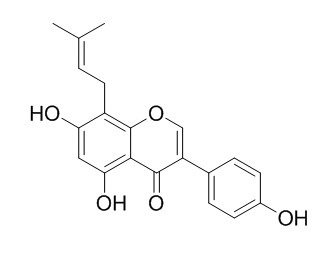Lupiwighteone
Lupiwighteone has anti-angiogenesis potential, it also has anticancer and cancer preventive effects on SH-SY5Y cells.
Inquire / Order:
manager@chemfaces.com
Technical Inquiries:
service@chemfaces.com
Tel:
+86-27-84237783
Fax:
+86-27-84254680
Address:
1 Building, No. 83, CheCheng Rd., Wuhan Economic and Technological Development Zone, Wuhan, Hubei 430056, PRC
Providing storage is as stated on the product vial and the vial is kept tightly sealed, the product can be stored for up to
24 months(2-8C).
Wherever possible, you should prepare and use solutions on the same day. However, if you need to make up stock solutions in advance, we recommend that you store the solution as aliquots in tightly sealed vials at -20C. Generally, these will be useable for up to two weeks. Before use, and prior to opening the vial we recommend that you allow your product to equilibrate to room temperature for at least 1 hour.
Need more advice on solubility, usage and handling? Please email to: service@chemfaces.com
The packaging of the product may have turned upside down during transportation, resulting in the natural compounds adhering to the neck or cap of the vial. take the vial out of its packaging and gently shake to let the compounds fall to the bottom of the vial. for liquid products, centrifuge at 200-500 RPM to gather the liquid at the bottom of the vial. try to avoid loss or contamination during handling.
Int J Mol Med.2016, 37(2):501-8
Int J Oncol.2016, 49(4):1497-504
Sci Rep.2023, 13(1):7475.
ACS Synth Biol.2022, doi: 10.1021.
Cell Mol Biol (Noisy-le-grand).2023, 69(15):167-173.
Int J Mol Sci.2024, 25(22):12152.
Food Chem.2023, 424:136383.
PLoS One.2021, 16(6):e0248479.
Mol Med Rep.2015, 12(5):7789-95
J Anal Toxicol.2021, bkab015.
Related and Featured Products
Anticancer Drugs. 2015 Jul;26(6):599-611.
Isoflavone lupiwighteone induces cytotoxic, apoptotic, and antiangiogenic activities in DU-145 prostate cancer cells.[Pubmed:
25734831]
Lupiwighteone (Lup) is an isoflavone-type compound. It is distributed widely in wild-growing plants such as Glycyrrhiza glabra, Lupinus, and Lotus pedunculatus. On the basis of existing research, Lupiwighteone shows antioxidant and antimicrobial effects, but its antitumor activity has not been reported as yet.
METHODS AND RESULTS:
This study aimed to examine the antitumor activity of Lupiwighteone, explore its antitumor mechanism in a human prostate carcinoma cell line (DU-145), and evaluate its antiangiogenetic activity in the human umbilical vein endothelial cell line (HUVEC). The results showed that Lupiwighteone could inhibit the growth of DU-145 and HUVEC cells in a concentration-dependent and time-dependent manner by a 3-(4,5-dimethylthiazol-2-yl)-2,5-diphenyl tetrazolium bromide assay. Flow cytometry analysis indicated that Lupiwighteone could induce cell cycle arrest, cells apoptosis, mitochondrial membrane potential loss, and an increase in intracellular reactive oxygen species of DU-145 cells. Upregulation of Bax, cytochrome c, caspase-3, and PARP-1 protein expressions and downregulation of Bcl-2, procaspase-9, and p-Akt protein expressions were observed by western blot after the treatment of Lupiwighteone. Furthermore, the effects of Lupiwighteone on the cellular behavior of HUVECs were also investigated.
CONCLUSIONS:
Altogether, our data proved the anticancer and antiangiogenesis potential of Lupiwighteone.
Food Chem Toxicol . 2020 Jan;135:110863.
Lupiwighteone induces caspase-dependent and -independent apoptosis on human breast cancer cells via inhibiting PI3K/Akt/mTOR pathway[Pubmed:
31604113]
Abstract
Breast cancer is one of the most common causes of mortality in women. Lupiwighteone has anticancer effects in prostate cancer cells and neuroblastoma cells. However, the molecular and cellular mechanisms of Lupiwighteone effects on human breast cancer cells are not as well known. In the present study, we investigated the effects of Lupiwighteone on the proliferation and apoptosis of two different human cancer cells; MCF-7, an estrogen receptor (ER)-positive human breast cancer cell, and MDA-MB-231, a triple negative human breast cancer cell. Lupiwighteone treatment decreased the viability of MCF-7 and MDA-MB-231 cells. Lupiwighteone treatment resulted in apoptotic cell death in breast cancer cells, which was characterized by DNA fragmentation, accumulation of apoptotic cells, and nuclear condensation. We also showed that treatment with Lupiwighteone induced caspase-dependent apoptosis (up-regulation of caspase-3, -7, -8, -9, PARP, and Bax or down-regulation of Bid, Bcl-2), induction of caspase-independent apoptosis (up-regulation of AIF and Endo G on cytosol), and inhibition of the PI3K/Akt/mTOR signaling pathway (down-regulation of PI3K, p-Akt, and p-mTOR) in both MCF-7 and MDA-MB-231 cells. These results suggest that Lupiwighteone induces caspase-dependent and -independent apoptosis in both breast cancer cell lines via inhibiting PI3K/Akt/mTOR pathway.
Keywords: Anticancer; Apoptosis; Breast cancer cells; Caspases; Lupiwighteone; Natural products.
Biomed Pharmacother. 2015 Feb;69:153-61.
Lupiwighteone induces cell cycle arrest and apoptosis and activates the Nrf2/ARE pathway in human neuroblastoma cells.[Pubmed:
25661352]
Lupiwighteone (Lup) is a kind of natural isoflavone, but its pharmacological effect and active mechanism are rarely reported. This study aimed to investigate the anticancer and cancer preventive effects of Lup on human neuroblastoma (SH-SY5Y) cells.
METHODS AND RESULTS:
We found that Lup could inhibit SH-SY5Y cells growth in a concentration- and time-dependent manner. Further studies suggested that Lup could induce G2/M phase arrest associated with an evident decrease in cyclin B1/D1 and cyclin dependent kinase (CDK) 1/2/4/6 protein expressions. Moreover, Lup could regulate the changes of mitochondrial membrane potential and increase intracellular reactive oxygen species (ROS) production. After the cells were treated with Lup, topical morphological characteristics were observed; apoptosis-related protein expressions, such as Bax, cytochrome c, cleaved caspase-9, cleaved caspase-3 and cleaved PARP-1 were increased; and protein expressions, such as Bcl-2, procaspase-9, PARP-1 and P-Akt were decreased. These changes were observed simultaneously. In addition, Nrf2 transcription factor activation was detected by an ARE-GFP reporter assay. Nrf2 nuclear localization was then investigated using a fluorescence microscope. Furthermore, Nrf2 and Keap1 protein levels were determined by western blot.
CONCLUSIONS:
Our results may provide a scientific basis for the application of the anticancer and cancer preventive effects of Lup on SH-SY5Y cells.



